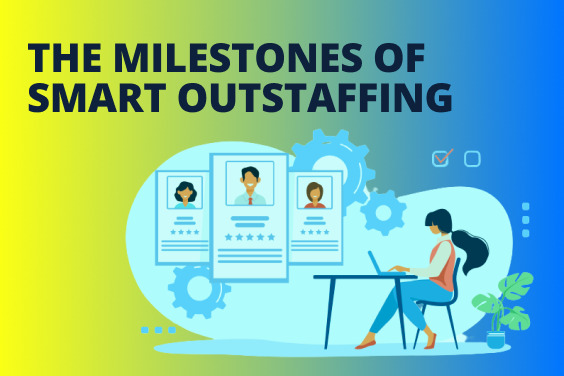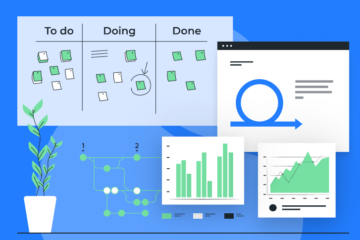The Milestones of Smart Outstaffing

Smart outstaffing is a strategic way to use outsourcing. It involves working with an outstaffing provider to build a remote team whose goals and objectives are in line with those of the company.
Reasons for Smart Outstaffing
Smart outstaffing is extremely beneficial to businesses in the following circumstances:
- The company is too busy to search for and train new software engineers in the peculiarities of the business and market.
- The product team is entering a brand-new market and need access to a wider range of resources than a single expert can provide.
- Business requires help with their upcoming round of investment and establishing strong project management practices.
- Internal resources lack the necessary capabilities to actively seek for the most talented individuals to work on their product.
Here are the milestones of smart outstaffing:
- Identifying business needs: The first milestone of smart outstaffing is identifying the specific business needs that the remote team will help address. This involves understanding the company's goals and objectives, and determining the specific skills and expertise needed to achieve those goals.
- Creating a talent profile: Once the business needs have been identified, the next milestone is to create a talent profile that outlines the specific skills, experience, and other requirements needed for each role on the remote team.
- Talent selection: With the talent profile in hand, the outstaffing provider can then begin to identify and screen potential candidates for each role. This involves evaluating candidates based on their skills, experience, and other qualifications, as well as their fit with the company's culture and values.
- Team formation: Once the remote team has been selected, the outstaffing provider will work with the company to onboard the team and integrate them into the company's existing workflows and processes. This may involve training and development programs to make sure that the goals and objectives of the remote team are in line with those of the company.
- Project management and oversight: Once the remote team is in place, the outstaffing provider will work with the company to provide ongoing project management and oversight. This may involve regular check-ins and progress reports, as well as support for project planning and execution.
- Continuous improvement: Finally, smart outstaffing is an ongoing process of continuous improvement, with the outstaffing provider and the company working together to identify areas for improvement and optimize the performance of the remote team. This may involve feedback and performance reviews, as well as ongoing training and development programs to help the remote team continue to grow and develop.
Overall, smart outstaffing is a strategic and proactive approach to outsourcing that focuses on building a remote team that is fully in line with the company's goals and objectives. By hitting these milestones, companies can take advantage of the benefits of outsourcing while making sure that the remote team is fully integrated into the company's workflows and processes.
What is the difference between Smart Outstaffing and Conventional Outstaffing?
Smart outstaffing is a relatively new approach to outstaffing that differs from conventional outstaffing in a few key ways.
Conventional outstaffing involves hiring a team of IT professionals from a third-party provider and integrating them into a company's existing team. The third-party provider takes care of administrative tasks like payroll and taxes, and the company is in charge of managing the remote team and making sure they are working toward the company's goals.
Smart outstaffing, on the other hand, is a more strategic approach to outstaffing that goes beyond simply hiring a team of remote IT professionals. Smart outstaffing means working with a company that not only provides a team of IT professionals but also takes a more active role in managing the remote team and making sure they are in line with the company's goals and objectives.
Key differences between Smart Outstaffing and Conventional Outstaffing
- Strategic alignment: Smart outstaffing involves a more strategic approach to outstaffing, where the outstaffing provider works closely with the company to make sure that the remote team is aligned with the company's goals and objectives. To make sure the remote team is working on the most important projects and tasks, they may need to meet regularly and work together.
- Management and oversight: Smart outstaffing providers take a more active role in managing the remote team and making sure they do good work. This could include regular check-ins, help with project management, and other ways to make sure the remote team is meeting the company's expectations.
- Talent selection and retention: Smart outstaffing providers may take a more proactive approach to talent selection and retention, working closely with the company to find the most qualified IT professionals for the job and making sure they are happy and engaged with their work. This may involve offering training and development opportunities as well as other incentives to help retain top talent.
Overall, smart outstaffing represents a more strategic and proactive approach to outstaffing that can help companies get the most out of their remote teams. By working closely with an outstaffing provider to ensure strategic alignment, management and oversight, talent selection and retention, and strategic alignment, companies can better use the benefits of outstaffing and reach their business goals faster.
The main advantages of smart IT outstaffing:
- Access to highly skilled talent: Smart IT outstaffing allows companies to access highly skilled IT professionals from around the world, including those with specialized skills and expertise that may not be available locally. This can help companies to build a high-performing IT team that can deliver high-quality work.
- Cost savings: Smart IT outstaffing can be a cost-effective way to build and manage an IT team, as it eliminates the need to hire full-time employees and provides access to a larger pool of talent at a lower cost. Smart IT staffing companies also take care of administrative tasks like payroll and benefits, which cuts costs even more of redundancy from the client.
- Scalability and flexibility: Smart IT outstaffing allows companies to quickly scale their IT teams up or down as needed, depending on project requirements and business needs. This can be particularly beneficial for businesses with fluctuating demand for IT services.
- Focus on core competencies: By outsourcing IT projects and tasks, companies can focus on their core competencies and strategic goals, while leaving the technical details to the remote team. This can help to improve efficiency and productivity, as well as free up internal resources for other business-critical activities.
- Faster time-to-market: Smart IT outstaffing can help companies to get their products and services to market faster by providing access to a team of highly skilled IT professionals who can work quickly and efficiently. This can be particularly beneficial for companies operating in fast-paced industries.
- Reduced risk: Smart IT outstaffing providers typically handle the recruitment, training, and management of the remote team, reducing the risk and administrative burden associated with hiring and managing full-time employees. Additionally, smart IT outstaffing providers often offer performance guarantees, ensuring that the remote team delivers high-quality work on time and within budget.
By partnering with the right outstaffing company, companies can build a high-performing remote team that is fully aligned with their goals and objectives.
Main Steps in Cooperation with Smart Outstaffing Company
Overall, the most important parts of working with an outstaffing company are figuring out what your business needs are, finding the right people for the job, getting the remote team started and integrated, providing ongoing project management and oversight, and improving the performance of the remote team all the time. By going through these steps, companies can take advantage of the benefits of outsourcing while making sure that the remote team is fully integrated into the workflows and processes of the company.
Cooperating with an outstaffing comapny involves several crucial steps, including:
Step 1: Needs Assessment
The first stage of cooperation is a needs assessment. This means figuring out what the business needs are that the outstaffing organization will help with, as well as what skills, experience, and other qualifications each role on the remote team needs.
Step 2: Talent Selection
Once the business needs have been figured out, the outstaffing organization can start to look for and screen possible candidates for each role. This involves evaluating candidates based on their skills, experience, and other qualifications, as well as their fit with the company's culture and values.
Step 3: Onboarding and Integration
Once the remote team has been chosen, the outstaffing organization will work with the company to bring the team on board and integrate them into the company's existing workflows and processes. This could include training and development programs to make sure the remote team is in line with the company's goals and objectives.
Step 4: Project Management and Oversight
Once the remote team is in place, the outstaffing organization will work with the company to provide ongoing project management and oversight. This could include regular check-ins and reports on how the project is going, as well as help with planning and carrying out the project.
Step 5: Continuous Improvement
The final stage of cooperation with an outstaffing organization is continuous improvement. This is done through a process of ongoing feedback and performance reviews, as well as ongoing training and development programs to help the remote team continue to grow and improve.
Why go for Smart Outstaffing with Ukrainian developers?
There are several reasons why companies may choose to go for outstaffing services in Ukraine:
- Highly skilled workforce: Ukraine has a highly skilled and educated workforce with a strong focus on science, technology, engineering, and mathematics (STEM) disciplines. Many Ukrainian IT professionals have experience working for international clients and are fluent in English, making communication and collaboration easier.
- Cost-effective: Outstaffing services in Ukraine are generally more cost-effective than in other countries, such as the United States or Western Europe. This is due to lower living and labor costs in Ukraine, making it an attractive destination for businesses looking to reduce their IT development and maintenance costs.
In general, the hourly rates for software development in Ukraine are lower than in the United States. However, the exact rates can vary depending on things like the type of project, the skills needed, and the developer's level of experience. Here are some approximate hourly rates for software development in Ukraine and the United States:
Ukraine: Hourly rates for software development in Ukraine can range from $25 to $50 per hour for junior developers, $50 to $75 per hour for mid-level developers, and $75 to $150 or more per hour for senior developers or those with specialized skills.
United States: Software development hourly rates can vary a lot from place to place in the U.S., with rates usually being higher in places like Silicon Valley or New York City. Hourly rates for software development in the United States can range from $100 to $250 or more per hour for mid-level and senior developers with specialized skills.
Even though hourly rates in Ukraine are usually lower than in the US, there are other things to think about when comparing software development costs between the two countries, like the level of expertise needed, the quality of the work, and the time and resources needed to finish a project. Also, working with an experienced outstaffing provider like HUD in Ukraine can help make sure that projects are finished on time and on budget, which can save US businesses even more money.
- Business-friendly environment: Ukraine has a favorable business environment with low taxes, a relatively simple regulatory framework, and a growing tech industry. Additionally, the Ukrainian government has made efforts to improve its business environment, including implementing reforms aimed at reducing corruption and streamlining bureaucratic processes.
- Cultural compatibility: Ukraine has a similar culture to many Western countries, including the United States, making it easier to work with Ukrainian outstaffing providers. Additionally, many Ukrainian IT professionals have experience working with Western clients and are familiar with Western business practices and culture.
- Time zone advantages: Ukraine is in a favorable time zone for businesses in the United States and Europe, with only a few hours’ time difference, making communication and collaboration easier.
Due to its highly skilled workers, low prices, and good business environment, Ukraine has become a popular place for IT outsourcing services. Any business can benefit from outstaffing to Ukraine in multiple ways.





No comments